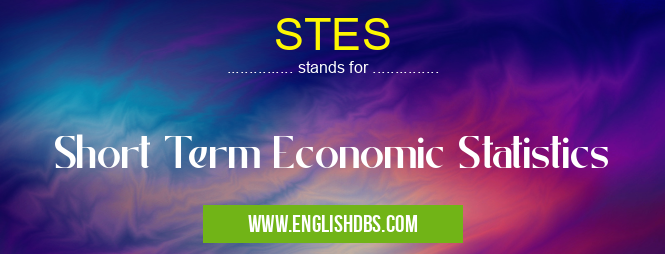What does STES mean in
STES stands for Short Term Economic Statistics. STES is a set of economic indicators that measure the performance of an economy over a short period of time, typically quarterly or monthly. These indicators provide insights into the current state of the economy and are used by policymakers, businesses, and economists to make informed decisions.

STES meaning in in Governmental
STES mostly used in an acronym in Category Governmental that means Short Term Economic Statistics
Shorthand: STES,
Full Form: Short Term Economic Statistics
For more information of "Short Term Economic Statistics", see the section below.
» Governmental »
Key Features of STES
- Timeliness: STES data are released on a regular schedule, ensuring that they are up-to-date and reflect the latest economic trends.
- Comprehensiveness: STES cover a wide range of economic sectors, including employment, production, trade, and prices.
- Reliability: STES data are collected through standardized methods, ensuring their accuracy and consistency.
- Accessibility: STES data are easily accessible through various government agencies and economic databases.
Types of STES Indicators
STES indicators fall into several broad categories:
- Output and Income: Measures economic growth and productivity, such as gross domestic product (GDP) and personal income.
- Employment and Labor Force: Tracks changes in the labor market, including employment, unemployment, and wages.
- Prices and Inflation: Monitors price changes in various sectors of the economy, such as the consumer price index (CPI) and the producer price index (PPI).
- Investment and Capital Formation: Measures investment in fixed assets, such as equipment and construction.
- International Trade: Tracks the flow of goods and services across borders, including imports and exports.
Applications of STES
STES data are widely used for:
- Economic Forecasting: Identifying economic trends and predicting future economic performance.
- Policymaking: Informing government decisions on fiscal and monetary policy.
- Business Planning: Evaluating economic conditions and making strategic business decisions.
- Research and Analysis: Conducting economic research and understanding market dynamics.
Essential Questions and Answers on Short Term Economic Statistics in "GOVERNMENTAL»ECONOMY"
What is STES?
STES (Short Term Economic Statistics) is a compilation of statistics on various aspects of the economy that provides insights into short-term economic trends. These statistics are typically released on a monthly, quarterly, or annual basis and cover a wide range of economic indicators.
What types of indicators are included in STES?
STES typically includes indicators related to:
- Production and Output: Industrial production, retail sales, wholesale trade, consumer spending.
- Labor Market: Unemployment rate, job creation, wages and salaries.
- Prices: Inflation rate, consumer price index, producer price index.
- Financial Markets: Stock market indices, bond yields, foreign exchange rates.
- Economic Sentiment: Consumer confidence index, business investment plans.
- International Trade: Exports, imports, trade balance.
How are STES used?
STES are used by economists, policymakers, businesses, and investors to:
- Monitor Economic Performance: Track economic growth, inflation, and other key indicators.
- Forecast Economic Trends: Identify potential risks and opportunities based on leading indicators.
- Make Informed Decisions: Guide fiscal and monetary policies, investment strategies, and business plans.
Where can I access STES data?
STES data is typically available through national statistical agencies or central banks. Examples include:
- United States: Bureau of Economic Analysis (BEA)
- European Union: Eurostat
- United Kingdom: Office for National Statistics (ONS)
- Japan: Statistics Bureau of Japan
How often are STES data released?
The frequency of STES data releases varies depending on the indicator. Some indicators, such as unemployment rate, are released monthly. Others, such as quarterly financial reports, are released quarterly. Annualized data is also commonly available.
Final Words: STES are essential economic indicators that provide valuable insights into the short-term performance of an economy. They are used by a wide range of stakeholders to make informed decisions and navigate economic challenges. By monitoring STES data, policymakers, businesses, and economists can stay abreast of current economic conditions and anticipate future trends, contributing to economic stability and growth.
